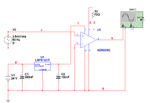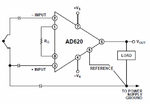lantz
Newbie level 4
Greetings folks,
I am attempting to construct a very simple thermocouple amplifier, and due to me not knowing, well, much at all, really, about analog electronics, it’s not working very well. Or at all, that is.
So I was hoping you guys could check my circuit out and tell me where I screwed up!

It’s really simple (maybe too simple?). It’s going to be powered from a 24 volt source, so there’s a regulator and some capacitors. Also, I’ve omitted any cold junction compensation for the reason that I only need to be able to detect a change in temperature (absolute temperature is not important). I’m using the AC source to simulate the range of voltages. Though I suppose this is too different from a thermocouple for the simulation to be useful.
I’ve tried the IC above, as well as an INA121, which produced roughly the same results. I’ve tried putting a 10k resistor between the thermocouple negative lead and ground, between the positive lead and ground, as well as between the two leads, but this doesn’t do much good it seems.
While trying this on my breadboard I mainly get random voltages which don’t seem to relate to the junction temperature. Does having too many hops from the TC to the inputs of the AD620 break things totally or should it still show some sort of useful value?
I have seen some other IC’s that does this, but they all seem to have a low amplification (up to a few mV). This is going to be used with some older, less precise, equipment, so I’d rather go up to a few volts instead. I've checked out some datasheets for these IC's, and they all say I should be able to do this like I've done, but I guess not!
Any help would be greatly appreciated!
Thanks,
Lantz
I am attempting to construct a very simple thermocouple amplifier, and due to me not knowing, well, much at all, really, about analog electronics, it’s not working very well. Or at all, that is.
So I was hoping you guys could check my circuit out and tell me where I screwed up!

It’s really simple (maybe too simple?). It’s going to be powered from a 24 volt source, so there’s a regulator and some capacitors. Also, I’ve omitted any cold junction compensation for the reason that I only need to be able to detect a change in temperature (absolute temperature is not important). I’m using the AC source to simulate the range of voltages. Though I suppose this is too different from a thermocouple for the simulation to be useful.
I’ve tried the IC above, as well as an INA121, which produced roughly the same results. I’ve tried putting a 10k resistor between the thermocouple negative lead and ground, between the positive lead and ground, as well as between the two leads, but this doesn’t do much good it seems.
While trying this on my breadboard I mainly get random voltages which don’t seem to relate to the junction temperature. Does having too many hops from the TC to the inputs of the AD620 break things totally or should it still show some sort of useful value?
I have seen some other IC’s that does this, but they all seem to have a low amplification (up to a few mV). This is going to be used with some older, less precise, equipment, so I’d rather go up to a few volts instead. I've checked out some datasheets for these IC's, and they all say I should be able to do this like I've done, but I guess not!
Any help would be greatly appreciated!
Thanks,
Lantz


